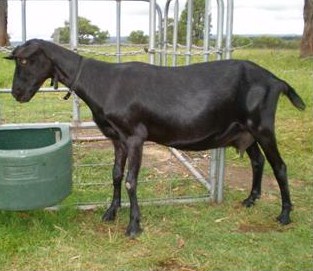

|
HOME BACK |
||
The Australian Melaan Breed standard |
||
|
GENERAL APPEARANCE (style & quality): Tall, rangy and graceful with smooth blended body exhibiting a pronounced double dairy wedge shape, fine but not inclined to weakness. Does feminine, bucks obviously masculine in appearance. HEAD (skull, eyes, ears, mouth, nostrils): Head long, facial line dished or straight, polled or neatly disbudded. Eyes set well apart, full and bright. Ears long erect, high set, may point slightly forward. Muzzle well developed without coarseness. NECK: Blending smoothly into shoulders. Does long and fine. Bucks long, fine but strong not coarse. With or without tassels which if present must be black. BACKLINE: Back strong, straight and horizontal or slighly rising to the hips. FOREQUARTERS: Withers fine and high, blending firmly into the shoulders. Chest full between the forelegs, deep in bucks, fairly deep in does, smoothly blending when viewed from front and side. |
 |
|
|
BODY: Abdomen well rounded, large and deep, wedge shaped, of proportionate length to height. HINDQUARTERS: Gradual slope from the hips to the tail, good width between hips, thurls and escutcheon. Rump long and flat, pin bones wide and prominent. Tail of good length, carried straight. LEGS (HOOVES): Long strongly boned legs but not coarse or heavily bones. Front legs straight and parallel from front and side. Hind legs straight and parallel viewed from the rear, hocks slightly bent when viewed from the side. Pasterns strong and fairly short, hooves sound, well shaped and preferably solid black. UDDER: Back attachment high and broad, fore attachment carried well forward and blending smoothly into the abdomen. Not penduIous or unduly divided, showing evenness and good capacity. Skin colour black grey and softly textured. TEATS: Two of adequate size for ease of milking, well attached and distinct from the udder. Set well apart, pointing slightly forward and down, not outward. RUDIMENTARY TEATS: Two set wide apart, slightly to the fore and sides of the scrotum, of good size but not overdeveloped (unless the buck is milking). TESTICLES: Scrotum well attached, relatively even and not unduly divided or penduIous. COAT and SKIN: Coat, short, fine and glossy. May have a fine grey undercoat. Bucks may have a longer coat but fine and glossy. All external skin is to be black, blue or grey and finely textured. COLOUR: Even intense black with no tendency to salt and pepper markings. SIZE (height): Does 32 inches (81 cms) Bucks 37 inches (94 cms). DIFFERING FROM THE IDEAL (found and recognised): Less than intense black. Horned. Nose with slightly raised bridge. Uneven tassels. Longer fringe along backline and on hindquarters on does. FAULTS: White sparse hairs around the throat &/or tassels, feet, udder, scrotum. Lack of dairy quality. Cow hocks, steeply sloping rump. Weak or dropped pasterns. Roach back or away back. Ewe necked, short beefy neck. Forequarters winged and unblended. Size substantially differing from ideal. Uneven gait, splayed or poor feet. Low set or short ears. Weak or narrow chest, shallow body. Fleshy, penduIous or uneven udder, pocket in the udder, weak medial suspensory ligament in the udder. Teats small, thin, large, bulbous, ill-defined or unbalanced. Lack of milking capacity. Lack of masculinity in bucks, divided, uneven or unduly penduIous scrotum. Uneven black colour. Short tail or tail carried slightly crooked. Rusty black coat colouring. DISQUALIFICATIONS: White fleck/spot/patches on the body, legs, head or chest. Tan or white Swiss markings (all or part). Pendulous ears. Parrot mouth or obviously undershot jaw. Wry face. Tan or pink skin. Double teats, double orifices, supernumerary teats. Intersex. Cryptorchid (undescended testicles) or monorchid (one testicle only) in bucks.
History of the Melaan The Australian Melaan takes its name fron its colour and what is thought to be its origin in a Saanen buck imported in 1943. The 'Mel' is from melanin or black pigment and the 'aan' is from Saanen. Thundersley Vanquisher, though white, carried colour and is famous for producing prize-winning Saanen, Toggenburg and British Alpine kids. He also produced black offspring that were mated with British Alpines. It is thought that Vanquisher carried the black gene from the black dairy breeds the Spanish Granada or Murcian. Over the years there have been Toggenburgs and British Alpines unrelated to Vanquisher who have produced solid black kids. Pror to the introduction by the DGSA of an Experimental Listing for all black goats, these kids were either destroyed or bred back into an existing breed, usually the British Alpine. This helped establish the gene for solid black in the British Alpine. Solid blacks were first accepted as an experimental breed by the DGSA in 1995 and was named and recognised as a breed in 2000. Since then they have proven themselves to be a popular breed suited to Australia's variable weather conditions. They are found from the sub-tropics to the far south of the continent. they are a particularly intelligent breed as well as being highly productive.
|
||